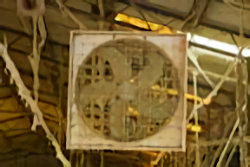Ventilation
Ventilation in the workplace refers to the process of supplying, distributing, and removing air within a building to maintain a healthy and comfortable indoor environment. OSHA requirements for ventilation can be found in 1926.57 - Ventilation.

Ventilation is a key part of occupational safety and health, as it helps control exposure to airborne contaminants and improves overall indoor air quality.
Workplace ventilation systems are designed to provide:
- Fresh air supply – Bringing in clean outdoor air to dilute indoor contaminants.
- Examples: Opening intake vents in a manufacturing facility to bring in fresh air and reduce buildup of welding fumes; using natural ventilation, such as open windows or roof vents, in warehouses to reduce heat and improve airflow; and supplying filtered outdoor air in cleanrooms to maintain controlled environments for sensitive equipment.
- Contaminant removal – Reducing or eliminating dust, fumes, vapors, and other harmful substances from the air.
- Examples: Local exhaust ventilation (LEV) systems in woodworking shops that capture sawdust directly at the source; fume hoods in laboratories to contain and exhaust hazardous chemical vapors; and exhaust fans in paint booths that remove overspray and solvent vapors.
- Moisture control – Managing humidity levels to prevent mold growth and maintain comfort.
- Example: Using dehumidifiers and exhaust fans in commercial kitchens to reduce steam buildup; installing ventilation in locker rooms to prevent excess humidity and mold growth on walls; and employing bathroom exhaust systems in office buildings to minimize moisture and odor problems.
- Temperature regulation – Supporting heating and cooling systems to keep the workplace comfortable.
- Examples: Ventilation ducts working with HVAC systems in office buildings to provide consistent heating and cooling; ceiling-mounted fans in warehouses that help distribute air evenly in large open spaces; and ventilated workstations in electronics assembly areas that prevent overheating of sensitive equipment.
- Protection of worker health – Lowering the risk of respiratory problems, allergic reactions, and long-term health effects from poor air quality.
- Examples: Hospital ventilation systems designed to reduce the spread of airborne diseases such as tuberculosis; negative pressure isolation rooms that prevent infectious particles from escaping into common areas; and ventilation in underground mining operations that removes diesel exhaust and provides breathable air.
Knowledge Check Choose the best answer for the question.
5-11. Which of the following is an example of contaminant removal in workplace ventilation?
- Bathroom exhaust systems preventing moisture buildup
You forgot to answer the question!
